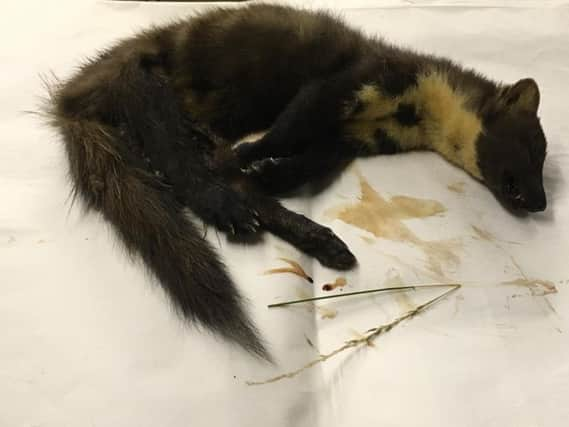Rare pine marten spotted in Derbyshire for first time in 16 years


The pine marten was once the second most common carnivore in Britain, but the loss of its habitat, the fur industry and culling associated with game shooting has driven the species close to extinction in England.
The last confirmed sighting of a pine marten in Derbyshire, according to the Derbyshire Mammals Directory, was in 2002.
Advertisement
Hide AdAdvertisement
Hide AdIt was shot by lampers at Baslow and is now a taxidermy specimen on display in the Sheffield Museum.
Wildlife photographer Andy Parkinson spotted the creature as he was on route to Wales however, realising its importance he passed on the information which enabled its body to be retrieved.
Lizzie Croose, who heads up the Vincent Wildlife Trust's work with pine martens, has since confirmed it was a male.
Angela Mason, Derbyshire Wildlife Trust’s Head of Living Landscapes South said: “This is a fantastic discovery. We would love to see pine marten’s return to Derbyshire.
Advertisement
Hide AdAdvertisement
Hide Ad"Pine martens need woodlands that are well connected and full of a mixture of species and food sources such as small rodents, birds, eggs, insects and fruit in order to thrive.
"We’re working hard to ensure there are more wild places across Derbyshire for these special mammals, especially within the Lower Derwent Valley within reach of where this one was discovered - we hope this will be the first of many!”
Pine Martens are now protected in the UK under the Wildlife and Countryside Act, 1981, and classified as a Priority Species in the UK Biodiversity Action Plan.
They are about the size of a cat and can be identified by their round ears, long tail and chestnut brown fur with a creamy yellow bib over the throat and chest.
Advertisement
Hide AdAdvertisement
Hide AdThey come from the Mustelidae family, so are related to weasels, ferrets, polecats and otters.
Male pine martens defend large territories up to 25km-sq and can travel as far as five miles in a single night.
They are also shy and mostly nocturnal, although they do sometimes come out during the day in summer, and while they don’t hibernate in winter, they venture out less.
There have been several sightings of pine martens in Derbyshire over the years but little physical or photographic evidence.
Advertisement
Hide AdAdvertisement
Hide AdThe creatures are so elusive, they are mainly studied from their footprints, droppings and bits of lost fur rather than from sightings.
If you think you have seen a pine marten, please report your sighting to the Wildlife Trust.
As a direct result of the sighting, the Derbyshire Wildlife Trust are now looking to set up trail cameras in the area to find more evidence of the elusive creatures.
To learn more about pine martens please visit Derbyshire Wildlife Trust’s website: www.derbyshirewildlifetrust.org.uk/wildlife-explorer/mammals/pine-marten